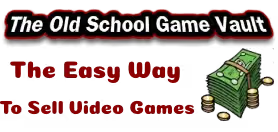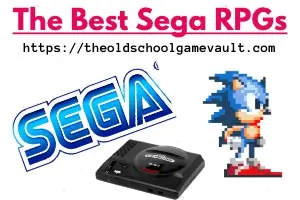Light gun shooters have been a cornerstone of arcade gaming since the golden age of coin-ops. But outside of arcades, most gamers’ experiences rarely go beyond Duck Hunt—and that’s where the story usually ends.
Today, that changes. With a Sega Saturn console , the official Saturn light gun accessory , a CRT television, and the five must-play games listed below, you can bring the full arcade experience home.
These are the best Sega Saturn light gun games ever released—and some of the finest console shooters of their era. We’ve ranked them from best to worst, but even the last-place entry is still worth playing. Let’s dive in and see what your retro library might be missing.
The Table of Contents
The Best Sega Saturn Light Gun Games You Need to Play
Area 51 – The Ultimate Arcade Alien Shooter Comes Home
- In the glory days of arcade light gun shooters, the mid-1990s, there were many options to choose from. Among this plethora, one game reigned supreme:
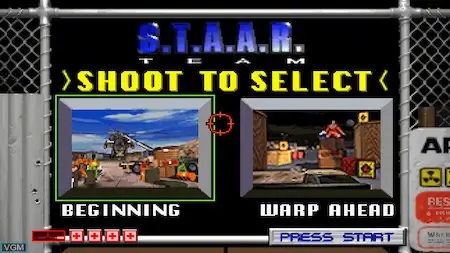 Area 51.
Area 51.
- And it’s no wonder why it was the ultimate shooter
- It’s a nonstop, heart-pumping, rapid-fire dash to destroy the evil aliens before they take out the entire world. (This meant a lot to us at the time, when The X-Files was the most popular show on TV.)
-
IGN praised Area 51 for its colorful enemy variety and relentless action, calling it a standout among home console light gun ports [IGN, 1998].
Area 51’s Hidden Bonuses and Replay Value
-
- Awesome weapon upgrades, life-saving health power ups, and secret bonus levels you trigger by shooting certain objects.
-
- So, which objects should you target? That’s the trick. Almost everything on the screen can be shot and destroyed.
-
- Many objects do nothing when broken. Some explode to harm enemies, and others contain power ups and hidden bonus levels.
-
- In other words, there’s always something to shoot. Blink and you’ll probably miss something important.
-
- Also, there’s not usually enough time to shoot everything. So you’ll want to experiment by replaying each level about, oh, a thousand times or so.
Reload or Die – The Arcade Experience at Home
-
- Additionally, you must reload constantly by shooting offscreen, occasionally whacking a fellow arcade patron in their carelessly oblivious face. You don’t have time to watch out for real-life faces! If you don’t time your reloads right, you’ll miss a crucial power-up or fail to stop an alien’s attack.
-
- Hopefully, you now understand why 90s kids would wait in a 45-minute line, each one lugging 1½ pounds of quarters in a Ziplock bag and easily spending 20 dollars for one more chance to finally destroy the mothership before it gets away. Oh, and did we mention it’s a 2-player co-op?
The Saturn Port: Still Worth Playing
-
- So, how does the Saturn port measure up? Well, it’s a lot cheaper to play since it doesn’t cost you 50¢ each time you continue. Other than that, it’s a slightly scaled-down but decently faithful port.
-
- That said, the ability to give yourself plenty of lives free of charge can sorta make the game too easy. Fortunately, you can adjust the difficulty level and the number of lives to suit your personal skill level.
-
- Lastly, the two-player co-op and dual-gun single-player modes—not to mention everything described above—give this classic hit plenty of at-home replay value.
Love Saturn light gun games? Don’t miss our guide to the Best Sega Dreamcast Light Gun Games — featuring arcade hits like House of the Dead 2 and Confidential Mission!
Virtua Cop 2 – A Fast-Paced Shooting Gallery with Action Movie Vibes
- At first glance, the Virtua Cop series is, well, not attractive by modern standards. To illustrate, consider the flashy visuals of Area 51, a surprisingly smooth
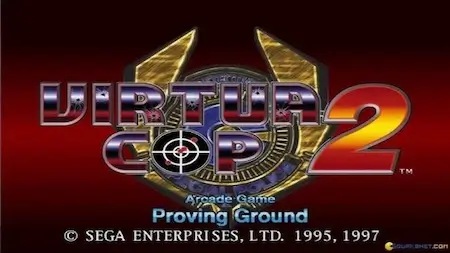 blend of live-action and CG FMV—almost hypnotic to watch, even today.
blend of live-action and CG FMV—almost hypnotic to watch, even today.
- In contrast, Virtua Cop 2 (released the same month as Area 51 in NA) seems to feature early PS1-quality polygons and more PS1-quality polygons.
- On the other hand, this illustration isn’t a fair comparison. These are two completely different types of shooters.
- Area 51 aims for a more realistic first-person experience—to make you feel like you’re actually running around some facility on foot.
- It also emphasizes shooting absolutely everything possible. Even the friendly (stupid, shot-blocking) NPCs are expendable with little penalty.
Why Virtua Cop 2 Still Stands Out
-
- Conversely, Virtua Cop 2 feels more like an action movie mixed with a classic shooting gallery. It’s basically the NES Zapper game, Freedom Force, but with better graphics and sound.
-
- That’s why the original Virtua Cop was such an international arcade hit. It was a then state-of-the-art upgrade to the beloved “shooting gallery video game” genre.
-
- Furthermore, Virtua Cop 2 improves upon its predecessor, adding layers of depth, better graphics, and a soundtrack that you can actually listen to without hating your ears. Its most notable feature is the ability for players to unlock different pathways in each level.
Multiple Paths = Maximum Replayability
-
- Some of these pathways are voluntary, chosen by the player at an actual fork in the road. Others are unlocked based on the player’s performance (saving a certain number of hostages, shooting baddies in the right order, etc.).
-
- Additionally, this game is more action-packed than the first Virtua Cop, ramping up the 90s “Xtreme” factor with some action-hero cop movie set-pieces. This includes baddies throwing grenades from helicopters and a high-speed car chase shootout.
-
- These exciting scenarios are the highlight of the game. They’re also a refreshing change of pace in a genre that’s essentially just a run-of-the-mill carnival shooting gallery.
Virtua Cop – The 3D Light Gun Classic That Changed the Genre
- Going further back to basics, the first Virtua Cop features simple shooting gallery gameplay at its finest. Again, this game may seem outdated at first
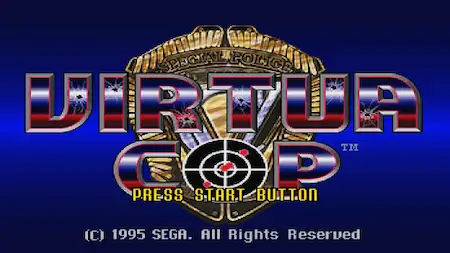 glance.
glance.
- Visually, its polygonal graphics are unimpressive by today's standards. And the gameplay can be a bit repetitive.
- Worst of all, it’s accompanied by a truly embarrassing soundtrack of synthesized anime rock.
Virtua Cop’s Groundbreaking 3D Innovations
-
- Still, at the time of its release, Virtua Cop was unbelievably ahead of its time. It introduced many new concepts to the shooting gallery genre and actually set the standard for a new generation of arcade light gun shooters.
-
- Most notably, it was the first fully-rendered 3D polygonal light gun arcade game ever.
-
- Prior to this title, light gun targets were limited to physical objects, 2D sprites, or cheesy video recordings of live-action cowboys.
-
- Thus, with 3D rendering based on the Virtua Fighter engine, Virtua Cop became the most interactive light gun shooter gamers had ever seen.
-
- The most impressive example is that the bad guys react differently depending on which body part you shoot. Watch his wounded arm flail, or see him stumble when shot in the leg. Shoot his head and he falls down dead.
-
- This innovation is massively more realistic than previous light gun shooters. Some newer Sega Saturn games even lacked this attention to detail. In Area 51, for example, every defeated enemy displays the same, generic “splat” animation.
Fast Reflexes and Innocent Bystanders
-
- Furthermore, the 3D environments allowed for more frequent, and impressive, location changes. There are also plenty of interactive background objects, like exploding barrels that harm nearby enemies when shot.
-
- Another highlight is that the game is a challenging mix of fast shooting and fast thinking. You must shoot enemies as fast as you can, or you lose a life. But, you must also avoid shooting any innocent bystanders.
-
- Each innocent you shoot also costs you a life. And there are a lot of these citizens who may run into your line of fire at any time.
-
- Shoot too fast, and you’ll hit a friendly, too slow and you’ll be shot yourself. Serious retro gamers owe it to themselves to experience this chapter in video game history firsthand.
Maximum Force – Area 51’s Forgettable Yet Fun Clone
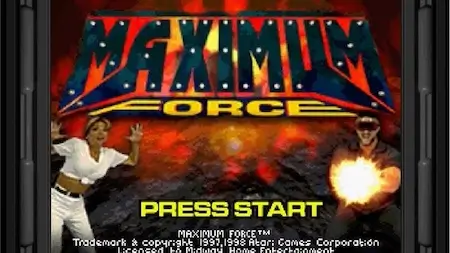
- Like the game itself, any review of Maximum Force is short and to the point. First, know that it’s Atari Games’ follow-up to their previous hit, Area 51.
- They hoped to duplicate the commercial success of Area 51 by essentially cloning the game itself, with some minor alterations and a title change.
- The result was exactly what you’d expect: a bland rehash of Area 51 with less personality and no aliens. On the plus side, if you want more action like Area 51, Maximum Force is where you’ll find it.
- It’s just sad that the game’s premise and visuals are so underwhelming.
The House of the Dead – Zombies, Guns, and a Choppy Port
House of the Dead is a more recent arcade hit that’s every bit as fun as Area 51 and Virtua Cop 2. The arcade version is the original zombie-shooting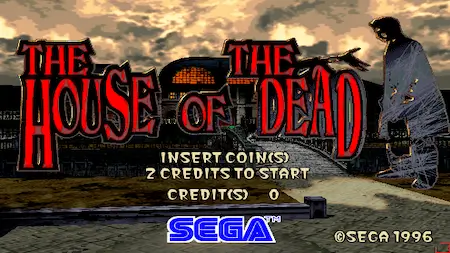 masterpiece that kicked off the whole zombie-shooting genre in 1996, alongside Resident Evil, of course. Unfortunately, the main problem with this port was the limited technology of the Saturn console.
masterpiece that kicked off the whole zombie-shooting genre in 1996, alongside Resident Evil, of course. Unfortunately, the main problem with this port was the limited technology of the Saturn console.
- You see, the other arcade ports on this list were developed for older arcade systems, similar in their capabilities to the Saturn. Thus, they required almost no down scaling when ported to home consoles.
- Conversely, House of the Dead was based on state-of-the-art technology when it came out, while the Saturn was already 2 years old. Porting in this case required a lot of down scaling, and every aspect of the game took a hit.
- There were fewer polygons, reducing the hoards of undead in each area to a mere handful. The graphics were uglier all around, rendered with low-resolution skins.
- Furthermore, the frame rate was choppy, and the controls were sluggish, impacting gameplay. Then again, if you want to play a zombie-shooting light gun game at home, your options are surprisingly limited.
- As noted in Sega-16’s review, the Saturn port captures the core gameplay but suffers from “pixelated textures, framerate drops, and sudden mid-level loading times” that impact the overall experience [Sega-16, 2020]
Want to see how much smoother the sequel looked on Dreamcast? Check out our gameplay of House of the Dead 2!

Final Shots – The Best Saturn Light Gun Games Ranked
Ready, aim, fire! These Sega Saturn light gun games prove that the thrill of the arcade didn’t stay in the mall. With fast-paced gameplay, branching paths, and nostalgic action, these titles deliver serious firepower straight to your CRT.
Just remember—Sega’s light gun accessories require a CRT television for proper functionality. They won’t work on modern HDTVs, and here’s why.
🎯 Have Sega Saturn games to sell? Turn your retro collection into cash with our trusted trade-in service. Visit our Sega Saturn game selling page to get started!
Frequently Asked Questions – Sega Saturn Light Gun Games
Do Sega Saturn light guns work on modern TVs?
- No. Saturn light guns only work with CRT televisions due to how the light detection technology functions. HD, LCD, and plasma TVs are incompatible.
What's the best Sega Saturn light gun game?
- Most fans agree that Area 51 is the best Sega Saturn light gun game for its action-packed gameplay, upgrades, and two-player co-op mode.
Can you play Saturn light gun games without the gun?
- Technically, yes. You can use a standard controller, but it greatly reduces the fun and responsiveness of the games designed for light gun play.
What is the full Sega Saturn light gun games list (NTSC only)?
- These are the official Sega Saturn light gun-compatible games released in North America. All require a CRT television and the Saturn Stunner or Virtua Gun accessory:
- Area 51
- Crypt Killer
- Die Hard Trilogy (light gun works only in Die Hard 2 segment)
- The House of the Dead
- Maximum Force
- Scud: The Disposable Assassin (light gun works in “Scud Mode”)
- Virtua Cop
- Virtua Cop 2

